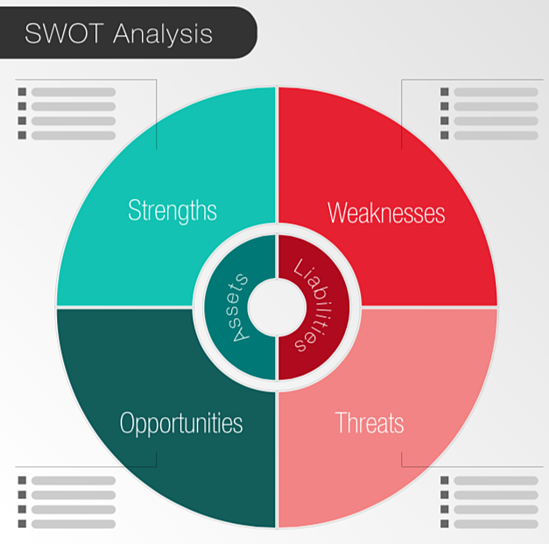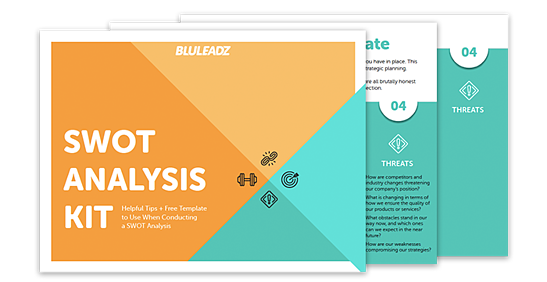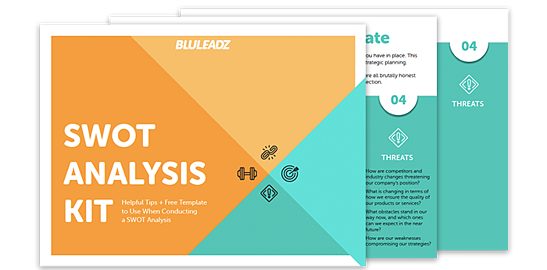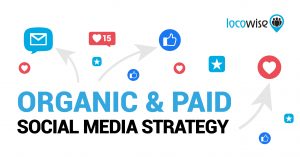As you are strategizing for business growth, you might realize that you need to reset and consider what your business is doing well, what you’re struggling with, what your growth opportunities are, and what obstacles stand in the way of your goals.
The best way to check in with the health of your business and to gain a better perspective on how you can grow is conducting a SWOT analysis.
What Is a SWOT Analysis?
SWOT Analysis Definition
To put it simply, a SWOT analysis is a framework companies use to better understand their competitive edge within their industry. It’s an essential tool to help all teams within an organization find how their performance stacks up.
Everyone gains insights on their risk factors within their operations and can find opportunities for improvement. Your whole company gets a visual of internal and external factors that could be slowing your growth and hurting your ability to achieve your goals.
SWOT Analysis Elements
SWOT breaks down to:
- Strengths
- Weaknesses
- Opportunities
- Threats
Strengths and weaknesses are the key factors that are internal to the enterprise developing an analysis. On the other hand, opportunities and threats are part and parcel with the market landscape.

In effect, weaknesses and strengths describe the resources you have or don’t have, while opportunities and threats are the aspects that make it easier or harder to achieve your goals. This lets you know what types of issues you need to address, mitigate, harness, or steer around.
Why You Need to Conduct a SWOT Analysis
What’s interesting about the SWOT analysis format is that you can actually apply it to any decision making process. On a large scale, a personal level, and anything in between, following this framework is always an excellent practice.
People use SWOT analysis for their personal career management, deciding how they want to advance their careers. But in the context of business management and strategic planning, using this framework yields many benefits for both senior leadership professionals and management teams.
Some of these benefits include:
- Gaining greater visibility for all teams
- Learning how to better allocate resources
- Reducing risks and improving upon weaknesses
- Becoming more competitive in your industry
- Streamlining day-to-day operations
One of the best ways to fully grasp this framework is by learning from the best of the best. A good SWOT analysis example won’t tell you absolutely everything you need to know, but it’ll start you on the road to a complete analysis. Ideally, this will prevent teams from overlooking some major factor that comes back to bite them later.
You and your teams won’t have to suffer from the regrets of missing out on new opportunities or falling victim to major threats you could not see. You also won’t take strengths for granted, and you won’t be able to ignore your weaknesses after conducting your own analysis.
This is why we need to look at the most recognizable brands and take a peak at their SWOT analyses.
The Top 3 Examples of Companies That Use SWOT Analysis
If you’ve never used a SWOT analysis before, a good way to think about it is in terms of today’s most successful brands. You can bet that companies like Amazon, Google, Tesla, and many others have used SWOT while moving toward some of their most impactful decisions.
Naturally, any SWOT analysis you perform isn’t going to be as detailed as what a Fortune 500 company would do for their board of directors. In these examples, we’re bound to leave out certain factors they would consider, just because we don’t have access to their secret vault.
Still, let’s get the idea by looking at three of the biggest companies around.
1. Apple
Strengths:
- The first U.S. company to reach $ 1 trillion valuation.
- 24% smartphone market share in the world – a close second but often high ranking.
- An iconic U.S. brand trading on instantly recognizable “look and feel.”
Weaknesses:
- Erosion of core brand promise after shift to iterative innovation.
- The loss of Steve Jobs is still felt operationally and by the public.
- Significant reliance on iPhone unit sales as a driver of revenue.
Opportunities:
- Health-related wearables provide new chances to expand the product ecosystem.
- Internet of Things capabilities will further integrate Apple into consumers’ lives.
- Robust mobile payments could put Apple front and center in daily transactions.
Threats:
- Labor and human rights concerns inherent in current supply chain.
- Widespread consumer anger over reports of hardware slowdowns.
- Growing international competition from low-cost alternatives.
2. Amazon
Strengths:
- Most recognized and trusted ecommerce brand worldwide.
- Remarkable logistics offer unmatched customer experience.
- Retail competitors serve as unwilling “Amazon showrooms.”
Weaknesses:
- Wide range of offerings, including some marginal and risky “blue sky” endeavors.
- Persistent reporting about potential safety and labor concerns at Amazon facilities.
- Extremely low margins on many offerings, further compromised by free shipping.
Opportunities:
- Launch of new headquarters offers both economies of scale and great publicity.
- Brand poised to benefit hugely from the development of in-house TV and films.
- Significant – maybe even unique – chances to grow operations in global markets.
Threats:
- Smaller online retailers often outperform Amazon in specific niches on price and quality.
- Expansion has highlighted Amazon as a regulatory target, spurring aggressive taxation.
- The retail-VR transformation in the coming years may present unexpected challenges.
3. Facebook
Strengths:
- Well over 2 billion monthly active users (MAUs) worldwide in a given month.
- Close to $ 8 billion in quarterly advertising revenue from a wide range of users.
- Iconic design elements such as the “like” fully integrated into offline culture.
Weaknesses:
- Decentralized approach to content leads to easy abuse, trolling, and fraud.
- User experience not usually considered world class, especially on mobile.
- Easy target for growing backlash against social media’s broader effects.
Opportunities:
- Company already winning kudos simply by agreeing to show family and friends content.
- Substantial new opportunities in emerging markets throughout Africa, Asia, and more.
- Humanitarian efforts show some promise in moderating brand’s least palatable aspects.
Threats:
- Abuse by foreign actors raises the specter of possible government regulation in future.
- Growing chorus of former users, including ex-execs who claim it is destroying society.
- Efforts to expand the depth and scope of advertising risk alienating users even further.
No matter what your situation is like, your SWOT analysis helps you start thinking broadly about it. Then, you can pair your SWOT with other approaches to dig deeper into the intricate details.
To get started on your own analysis, begin outlining it by asking the right questions.
How to Conduct a Company SWOT Analysis
SWOT Analysis Questions
- What do we do better than anyone in our industry?
- What is our company’s unique selling propositions (USP)?
- What does our audience perceive as our strengths?
- What elements make up our best success stories?
- Where exactly are we falling short in comparison to our competitors?
- What aspects could we improve on, and what areas should we avoid?
- What does our audience perceive as our weaknesses?
- What are the elements we can attribute to our biggest setbacks?
- What are the most popular trends happening in our industry right now?
- What are the best resources we can use to stay in the know on new opportunities?
- What changes occurred in our industry recently?
- What are the most obvious new opportunities we can jump on?
- How are competitors and industry changes threatening our company’s position?
- What is changing in terms of how we ensure quality of our products or services?
- What obstacles stand in our way now, and which ones can we expect in the near future?
- How are our weaknesses compromising our strategies?
Each section of your SWOT analysis matrix requires some deep thought. When you ask the right questions about your strengths, weaknesses, opportunities, and threats, this tool will deliver amazing insights.
Strengths
This section, which belongs in the top left section of your matrix, defines the characteristics of your business that give you a leg up on your competition.
To build out this portion, answer the following questions:
- What do we do better than anyone in our industry?
- What is our company’s unique selling propositions (USP)?
- What does our audience perceive as our strengths?
- What elements make up our best success stories?
These questions should get the ball rolling. When you’re evaluating your company’s strengths, you should consider them both from an internal point of view and from the perspective of your target market.
Weaknesses
In the top right portion of your SWOT analysis, you need to highlight the unpleasant truths about your company. It’s very important to be brutally honest with yourself and try to be as unbiased as possible when answering these questions:
- Where exactly are we falling short in comparison to our competitors?
- What aspects could we improve on, and what areas should we avoid?
- What does our audience perceive as our weaknesses?
- What are the elements we can attribute to our biggest setbacks?
Similarly, look at your weaknesses from both an internal and external perspective. This way, you get a full, honest picture.
Opportunities
The bottom left part of the matrix is where you include areas of opportunity for business growth. This is a great exercise in looking forward.
Answer these questions to fill out this section of your SWOT analysis:
- What are the most popular trends happening in our industry right now?
- What are the best resources we can use to stay in the know on new opportunities?
- What changes occurred in our industry recently?
- What are the most obvious new opportunities we can jump on?
At this stage of your SWOT analysis, things get a little tricky. You’re now considering where exactly to allocate resources to hit your growth goals.
When identifying opportunities, reflect back on your strengths and identify how putting your best foot forward in certain areas will create new favorable circumstances for your business. Then, re-evaluate your weaknesses to see how addressing certain weaknesses can yield new opportunities.
Threats
In the final section of your analysis, at the bottom right, list out all the threats, both real and potential, that are impacting your business. These questions will give you a comprehensive view of what is threatening your growth potential:
- How are competitors and industry changes threatening our company’s position?
- What is changing in terms of how we ensure quality of our products or services?
- What obstacles stand in our way now, and which ones can we expect in the near future?
- How are our weaknesses compromising our strategies?
Again, this requires some brutal honesty with yourself. You can’t afford to sugar coat what your liabilities are. If you do, you’ll be flying blind and could potentially hit several roadblocks along the way, hindering your business growth.
With all these answers for each section, you’re ready to fill out your SWOT analysis template.
How to Take Action on Your SWOT Analysis
You’ve filled out your awesome SWOT matrix. You know your strengths, weaknesses, opportunities, and threats, but what do you do with this information now?
To take action on your SWOT analysis, you must take two important steps:
- Match your strengths with your opportunities.
- Convert your weaknesses into strengths.
Here’s some essential advice on how to accomplish this.
Apply Your Strengths.
Your strengths represent things that your business already does well. Let’s say you own a retail store, and the strengths of this store are its location, good reputation, and quality clothing items.
This tells you that you should continue to nurture these strengths. Keep building your reputation by engaging with your regular customers in your community, and keep providing quality clothing.
To apply your business strengths only requires that you continue to do more of what you’re already succeeding at.
Understand Your Weaknesses.
Turning your weaknesses to strengths is tricky because it involves admitting your weaknesses, and then working to understand them. When trying to understand your weaknesses, you must determine what causes them in the first place.
Once you do that, you can then work on strategizing to find ways to position your weaknesses as strengths.
For instance, if one of your weaknesses was competing with large chain stores, you can repurpose that weakness by offering unique and personalized experiences for your customers that is trendy and exclusive.
This is something a chain retail store typically doesn’t offer.
Take Full Advantage of Your Opportunities.
The opportunities portion of your SWOT is the easiest to act on, and perhaps the most exciting portion of your SWOT. It highlights realistic ways to take your business to the next level.
Make sure you take advantage of these opportunities, no matter how well you think your business is doing. Failing to dedicate personnel, money, and time to maintain your advantages in the market may cause you to miss out on the opportunities in the long run.
The best way to take advantage of your opportunities is to create a roadmap for them that is clearly defined to help you capitalize on your opportunities. This roadmap should detail exactly what your desired outcome is and how you’re going to accomplish it.
Reduce Threats.
Reducing the threats your business faces may be the most difficult part of putting your SWOT analysis into action. Threats are mostly external factors, which means most of them can’t be predicted because they are beyond your control.
Typically, the most you can do is monitor and respond to threats as you notice them. The key is catching them at the right time and changing your strategies to reduce the threats.
However, threats like economic problems are nearly impossible to fully manage, which is why it’s important to develop a crisis management plan. When you’re proactive, you can reduce the damage of unpredictably crises in order to stay competitive and continue growing.
SWOT Analysis Template
As you answer the questions for each section (noted above), you should be documenting your findings. Once you finish each section, add all the information into this template, which you can update as needed and distribute to your internal teams.

Download the SWOT Analysis Kit Here 



Is a SWOT Analysis Right For You?
If you want to get all your teams on the same page, find ways to streamline operations, make the most out of your resources, and reduce risk while becoming more competitive, then absolutely, a SWOT analysis is a must for you!
While this tool can require a good deal of time and mental bandwidth, it yields a massive return – you have a comprehensive document to reference and use to guide your ongoing business efforts. Keep in mind: your analysis will evolve over time, so it’s important to revisit your SWOT matrix regularly and update it as needed.
Creating your SWOT analysis template and filling in the details is your best first step in strategizing for long-term, sustainable business growth. What are you waiting for?
Business & Finance Articles on Business 2 Community
(91)










